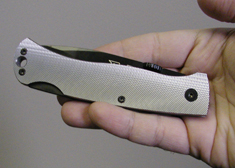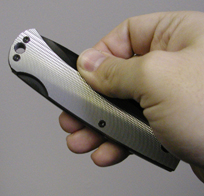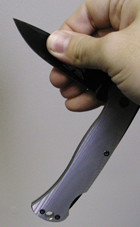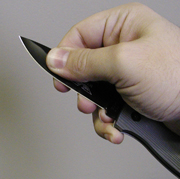its paid sponsors, whose products you need!
“Stay ‘unreasonable.’ If you
don’t like the solutions [available to you], come up with your
own.”
Dan Webre
The Martialist does not
constitute legal advice. It is for ENTERTAINMENT
PURPOSES ONLY.
Copyright © 2003-2004 Phil Elmore, all rights
reserved.
The New York Drop
By Phil Elmore
DISCLAIMER: USING A KNIFE IS INHERENTLY
DANGEROUS.
The Martialist
disclaims all liability for accidents that occur
while working with knives. Train safely with appropriate equipment,
including dull training knives where applicable.

I’m
not sure just why this folding knife opening method has been attributed to New
York as opposed to somewhere else, but we’ll call it that for the sake of this
article. The New York Drop is a means of opening a locking folding knife
with only one hand. It works best — actually, I should say it only works
— with knives whose blades protrude above the handle far enough to provide
purchase for the fingers.
The New York Drop is the preferred opening method of
RENOTT,
a knife fighting school in Ohio. I reviewed some RENOTT materials and spoke about
my reservations concerning this opening method in my
review:
| The “New York” open previously described appears to be the foundation for RENOTT’s knife defense, in that it is presented as the fastest way to open and attack with a knife. No repositioning of the hand is done (unless there is “time” for that). Rather, the RENOTT trainee opens his or her knife with the handle drop, and then, gripping the razor-sharp blade with his or her fingers, slashes with the exposed one or two inches of the knife. The companion text describes this as follows:
This technique strikes me as quite unsafe, anchored With practice it’s very
|
The fact remains that while it is useful to know how to do this, I
don’t consider it safe or preferable to a wrist snap (or to simply using your
knife’s opening stud or hole if the knife is equipped with one).
To perform the New York Drop, grasp the blade of a closed
folding knife between your fingers as shown. The more the blade
protrudes, the better your grip will be. The New York Drop works very well
with Spyderco knives, as most of them have pronounced “humps”
in
which the opening hole is set. (As there is no functional advantage that I
can see to performing this opening over using the thumb hole or a
wrist
snap, I’m not sure why you would do a New York Drop with a Spyderco,
but the fact remains that it’s easy to do with such knives.)

Holding the blade as firmly as possible, snap your hand sharply
using the action of your wrist. The weight of the handle should cause it to arc down and lock
into place. (This means, obviously, that the New York Drop is easier to
perform with a knife that has a heavy handle. Metal or wood-scaled handles
are preferable to plastic handles for this reason.)


When the handle snaps into place, aided by the force of your
wrist and by gravity, you will be holding the knife by the blade. You
could, I suppose, attempt to manipulate it while holding the blade (in the
fashion recommended by RENOTT), or you could shift the
blade in your hand so that you’re holding it properly.
As I said earlier, the risk of dropping a knife while performing this opening is
very great, as is the risk of cutting yourself (you’re holding a knife by the
blade, after all). Still, there may be times — particularly in utility
scenarios — when it’s useful to be able to open a knife with one hand while
taking advantage of the handle’s weight.
Decide for yourself.
